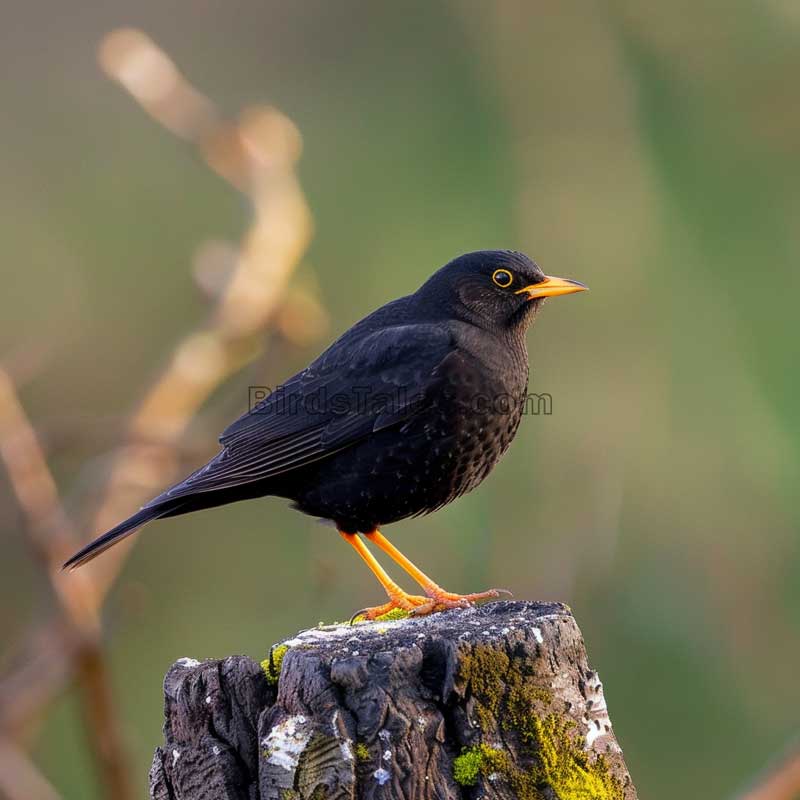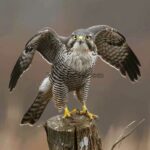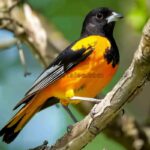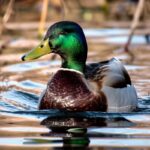Identifying the Common Blackbird
Identifying the common blackbird involves observing several key features.
These birds display noticeable differences between males, females, and juveniles.
Knowing these differences can help you spot them easily.
Male Blackbird Features
The male blackbird is quite striking.
Glossy black plumage covers its body, making it look sleek and elegant.
Its yellow eye-ring stands out, almost like it’s wearing tiny spectacles.
The orange-yellow bill is bright and noticeable, providing a sharp contrast against the black feathers.
In winter, this bill darkens, making it slightly less vibrant.
This seasonal change is fascinating and can help in identifying the bird during different times of the year.
The male’s plumage is consistent, offering a reliable identification marker throughout its life.
The American robin is a well-known bird in North America, easily recognized by its reddish-orange breast and cheery song.
Female and Juvenile Blackbird Features
Female blackbirds have a more subdued appearance.
They sport brown plumage that blends well with their surroundings, offering them some camouflage.
Their lighter throat and spotted breast are key features to look for.
These spots are not as pronounced as those on some other bird species, but they are there if you look closely.
Juvenile blackbirds resemble females but have pale spots on their upperparts.
These spots are temporary and will fade as they mature.
The young birds’ speckled breast is another characteristic to note.
As they grow, juveniles develop the features of either adult males or females, making their identification easier over time.
Common Blackbird Habitat and Range
The common blackbird is highly adaptable and can be found in a variety of environments across Europe, Asia, and Africa.
Understanding their preferred habitats and geographical distribution provides insight into their widespread presence and survival strategies.
Parrots are intelligent and colorful birds with strong beaks and unique feet. They are found in warm regions around the…
Preferred Habitats
Common blackbirds are adaptable and thrive in various environments.
They are found in:
- Woodlands: These provide a natural, protective environment. The dense foliage and abundant food sources make them ideal.
- Gardens: Many blackbirds are at home in suburban gardens. They find food, nesting sites, and a relatively safe habitat away from predators.
- Parks: Urban parks offer a mix of natural and human-made structures. Blackbirds use these areas for nesting and feeding.
- Urban areas: Surprisingly, these birds are also seen in city landscapes. They adapt to urban life, finding food in unexpected places and making nests in buildings.
Geographical Distribution
The common blackbird is widespread across multiple continents:
- Europe: From the chilly north to the sunny south, they are everywhere. Blackbirds are a common sight across countries, adapting to local climates and conditions.
- Asia: Western Asia, including regions with harsh winters, sees these birds thrive. They manage to survive and even flourish in diverse environments.
- North Africa: Here, they enjoy the milder winters. The varied landscape offers plenty of opportunities for feeding and breeding.
Some populations are resident, staying put all year.
Others migrate to warmer areas during the winter.
This behavior ensures their survival across a broad range of habitats and conditions.
Hawks are strong birds of prey from the family Accipitridae. They are found on every continent except Antarctica. These birds…
Diet and Feeding Behavior
The common blackbird’s diet and feeding behavior are as varied as their habitats.
These birds are omnivorous and resourceful, consuming a wide range of food items.
Observing their feeding habits reveals much about their adaptability and survival skills.
Omnivorous Diet
Blackbirds are true omnivores, eating a wide variety of foods.
Their diet includes:
- Worms: A staple, especially for feeding young. They are rich in protein.
- Insects: Beetles, ants, and more. They provide essential nutrients.
- Fruits: Berries are a favorite. These provide sugar and vitamins, especially important during colder months.
- Berries: Especially in autumn, when insects are less available. Berries are easy to find and eat.
Their diet changes with the seasons.
In summer, insects are plentiful.
In winter, fruits and berries are more common.
This flexibility is a key to their survival.
Feeding Behavior
The feeding behavior of blackbirds is interesting to observe:
- Foraging: They pull earthworms from the soil, often seen hopping and then stopping suddenly to listen and look.
- Leaf litter: They root through it, searching for hidden insects. This behavior shows their adaptability and resourcefulness.
- Hunting small animals: Occasionally, they hunt small amphibians, lizards, and even small mammals. This is less common but shows their versatility.
- Perching: They perch in bushes to eat berries, often seen flitting from branch to branch.
Their feeding methods are diverse and adaptable.
They use sight and sometimes hearing to locate food.
This variety in their feeding behavior ensures they find food in different environments and seasons.
Song and Communication
The common blackbird is not only known for its appearance but also for its rich and varied vocalizations.
Their ability to communicate through song and calls is fascinating and adds another layer to their charm.
Male Blackbird Song
The male blackbird’s song is a real treat for the ears.
It’s a varied and melodious tune, almost like a personal symphony.
You can often hear them during the early morning or late evening, their preferred times for singing.
This fluted warble is both complex and soothing, composed of low-pitched notes that flow beautifully.
Males sing from high perches, making sure their song carries far and wide.
This behavior serves multiple purposes: attracting mates, marking territory, and even signaling their health.
Imagine waking up to such a lovely sound – it’s like nature’s own alarm clock.
Their song varies between individuals, almost like a unique fingerprint, making each male’s song a bit different from the next.
Communication and Calls
Blackbirds are not just singers; they are quite chatty too.
They use a variety of calls to communicate different messages.
For instance, the aggressive seee calls are a clear indication of irritation or warning.
If a terrestrial predator approaches, you’ll hear a series of pook-pook-pook alarm calls.
It’s their way of alerting others to the danger.
When it comes to daily interactions, they use chink-chink contact calls.
These are shorter and less dramatic but serve the purpose of keeping in touch with each other.
If you watch closely, you might see them using visual signals too, such as wing flicks or body postures.
These subtle gestures add another layer to their communication, making them quite sophisticated in their social interactions.
Behavior and Territoriality
Common blackbirds exhibit a range of behaviors that are intriguing to observe.
Their territorial instincts, particularly during the breeding season, reveal a lot about their survival strategies.
Additionally, their social behaviors outside of breeding times showcase their adaptability and community dynamics.
Territorial Behavior
Blackbirds are known for their strong territorial instincts, especially during the breeding season.
Males are quite the defenders of their chosen spots.
They will chase away intruders with a combination of songs, calls, and physical displays.
It’s a bit like watching a tiny, feathered warrior in action.
When defending their territory, males often engage in what can be described as “boundary disputes.” They face off against each other, sometimes escalating to physical confrontations.
These disputes are usually resolved quickly, with one bird retreating.
It’s a high-stakes game of bluff and bravado, ensuring that the strongest and most determined males secure the best territories.
Social Behavior
Outside of the breeding season, blackbirds become more social.
They are often seen in flocks during migration and in wintering areas.
This shift from territorial to social behavior is fascinating and shows their adaptability.
They can be quite gregarious, especially when food is abundant.
Blackbirds also have unique social rituals.
Mating rituals, for instance, involve a lot of singing and display behaviors.
Males will often puff up their feathers and sing more intensely to attract females.
These displays are not just about looks but also about showing their vitality and suitability as a mate.
It’s a bit like a birdie talent show, with the best performer winning the prize.
Breeding and Nesting
The breeding and nesting practices of common blackbirds are meticulously orchestrated.
From nest construction to raising the young, these birds demonstrate remarkable dedication and care.
Nest Construction
The process of nest construction is an art form for the female blackbird.
She meticulously gathers materials like grasses, leaves, and mud.
The result is a neat, cup-shaped nest that’s both sturdy and comfortable.
These nests are often built in creepers, bushes, or even outbuildings.
Females are very particular about the location.
They prefer spots that offer some protection from predators and harsh weather.
Evergreen or thorny bushes are favorites, providing both cover and security.
The construction process takes several days, with the female working diligently to create a safe haven for her future chicks.
Raising the Young
Once the nest is ready, it’s time for the eggs.
A typical clutch consists of 3-5 eggs, which are pale blue with darker speckles.
The incubation period is around 10-14 days, during which the female does most of the sitting, keeping the eggs warm.
Both parents are involved in feeding the chicks once they hatch.
They bring a steady supply of worms, insects, and other food to the nest.
The chicks grow quickly, and within about two weeks, they are ready to leave the nest.
This fledging period is critical as the young birds learn to fly and fend for themselves.
The care doesn’t stop there.
Parents continue to feed and protect their fledglings for several more weeks until they are fully independent.
It’s a busy time, but seeing the young blackbirds grow and thrive is rewarding.
This period of parental care ensures that the young birds have the best possible start in life.
Conclusion
The common blackbird is a remarkable bird with diverse behaviors and habitats.
Observing them can be a rewarding experience, whether in woodlands, gardens, or urban areas.
Their song and adaptability make them a cherished sight for many bird watchers.





